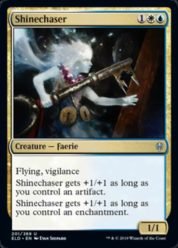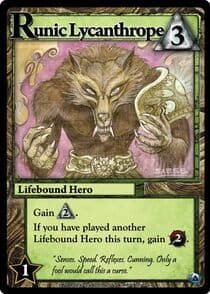When you design a game, people will judge it by their first play of it. If that first play goes poorly or if they feel lost, they might never want to play again. So part of our job as a game designer is to signal to a player how to play the game well enough to not feel lost, and to have fun.
Game Design: Sign Posts
There are plenty of ways to suggest to players how they should be playing. Potentially the most important of them is the sign post.
What are sign posts?

A sign post, in game design terminology, is a part of a game that suggests one of the strategies in that game. The term was coined by Magic: The Gathering Designers who started putting powerful build-around-me cards into every set to instruct players what the archetypes of that set are (for drafting purposes). This solves many of their problems: inexperienced players can figure out a strategy while playing the game, whereas before, they would need to look through the hundreds of cards in the set in order to figure out what the powerful synergies were. Additionally, the sign post card is multicolor, and that tells the drafter what colors that strategy exists in.
In Throne of Eldraine, the archetype in blue and white is based around controlling many artifacts and enchantments. The card above, ShineChaser, is super powerful if you have an artifact and enchantment, but underwhelming if you have neither. It tells the drafter if they want to draft blue and white in this set, they need to be playing artifacts and enchantments if they want to take advantage of the powerful synergies in those colors.

Many games use sign posts. In Ascension, one obvious sign post is the Runic Lycanthrope. This card suggests to you that if you get as many Lifebound heroes as you can, they will reward you with synergies like this one. Even a player unfamiliar with the cards in the game will have some faith that collecting as many Lifebound heroes as possible will probably be a fruitful strategy.
Any game with multiple strategies should consider having sign posts.
What do sign posts look like?
A sign post can take many different forms:
- Cards that reference a synergy needed to carry out a strategy.
- Asymmetrical character powers.
- Unlockable worker placement spaces.
- Cards with matching flavor (ie, if a card synergies with another card, naming one card “the Watchmaker”, and another card “the Broken Pocketwatch”).
- Achievements or milestones that force a player down a specific strategic path to achieve.
- etc.
What it looks like depends on your game, and the type of strategy game it is.
What kind of games need sign posts?
When a game has multiple distinct strategies, it should consider using sign posts. Now, when I say strategy, I mean long-term planning. A sign post will usually not help a player with tactical (turn by turn) planning.
Some designers are going to be hesitant to do sign posts: won’t a sign post reduce the complexity of the game? The short answer is no. Complex games are the ones that need sign posts the most. The long answer is that most gamers will not notice for what they are. Their largest function is to reduce initial complexity, the big hump of the initial learning curve that prevents people from fully enjoying the game.
The more powerful the synergies and strategies in the game are, the louder you need to broadcast them with sign posts. It’s an undesirable thing for a player to have an absolutely run away game, where that player may win by a huge margin. If players in the game want to quit because “the game is over, that player is going to win,” then something has gone wrong. And a sign post is one of the things that can fix that problem.
How do you do sign posts wrong?
Sometimes, games print sign posts that mislead a player. In order for a sign post to work, it must be situationally powerful when a player does that strategy. If that strategy you’re pointing to is weak, the player will have a bad time, and will feel like they were lied to.

For example, let’s make a hypothetical card for the game Sushi Go. But first some context for the game: in Sushi Go, you’re drafting cards that all score in different ways: a good card is worth 3 points, a great card is worth more than 3, and a card lower than 2 points is just bad.
Let’s say we have a card that says this: “Score 1 point for each Egg Nigiri you have.” Egg Nigiri is a card that simply scores 1 point.
A player will read that card, and think “this game will reward me for getting as many egg nigiri as possible.” However, if you get 5 egg nigiri (a huge number of them), you’d only score 10 points for 6 cards (5 for the egg nigiri, and 5 for our hypothetical card). That’s only 1.6 points/card, which means the player who goes all in on this strategy is probably going to lose (and that’s just about the best case scenario!). They will rightly feel frustrated: they were misled by the game. They properly read a sign post, but the sign post lied about rewarding them for accomplishing a difficult task.
It truly is important that a sign post is situationally powerful. The more a player wants to build around it, the more players will successfully find the strategy it’s sign posting, the more successful it is as a sign post.
Another way sign posts can go wrong is to make a sign post that point to a strategy that doesn’t exist in your game. For example, if a game implicitly promise to reward a player for collecting a certain type of card, and then it turns out there are only two of that kind of card in the game, that player will feel betrayed.
Another example is in Terraforming Mars. In that game, there is a milestone for getting 16 cards in hand. There are no cards in the game that reward you for cards in hand, and getting such a large hand size means you’re probably making really poor decisions as to what cards you buy.
What if players are missing my sign posts?
Most sign posts are obvious to experienced gamers, but they aren’t going to help all gamers. Casual gamers will likely miss them, fail to remember they have them, etc. And sometimes, if one sign post is discovered before the others, players will zealously go for that single strategy at the detriment of exploring others.
The power of sign posts is their subtlety, how they instruct without telling. If sign posts aren’t helping, consider doing even more to make it more obvious.
- Perhaps your sign posts are too subtle. If you could make it more powerful in an obvious way, players will want to build around it. Or perhaps you should make it interact with other cards more explicitly, like how Runic Lycanthrope specifically mentions the cards it deals with.
- Cards that interact positively could be color-coded. Perhaps they could all be factions or guilds, and each guild/faction has a different strategy.
- Amp up how synergistic cards make sense together thematically.
- Consider adding more sign posts: maybe let players choose an asymmetrical power that relates to each strategy. Maybe add goals/achievements that can only be completed by a player who is following a certain strategy.
- Consider adding some mechanic to convince players to explore more, or make a player’s ability to play a given strategy more random.
- Perhaps the game relies too much on knowledge of the game to play it well, and sign posts just won’t do enough to help. This isn’t always the worst thing, but know that it greatly limits your audience.
Conclusion
This was a brief little overview of sign posts. I’m working on a much larger project about how designing strategy in a game, which includes an expansion on this topic.


